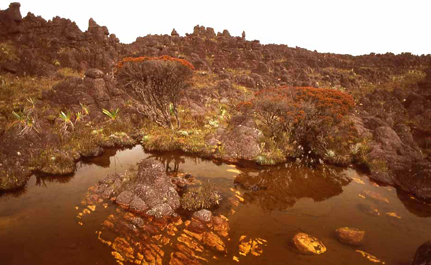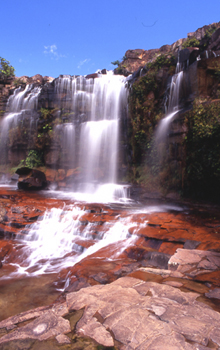
Geology
of Venezuela Tepui
I
have had
many questions concerning the geology of these unique and fantastic arches.
These arches are made from a sandstone called the Roraima Formation. All
of the Tepui are made from this basic rock type.While fantastic 'hoodoos'
and isolated arches are fairly common, we found one area where there is
an intense complex of arches which is perhaps unsurpassed throughout the
world.
The
Geology:
The entire
Guyana Shield consists of rock of igneous and metamorphic types, especially
granites and gneisses, some of which were formed 3.6 billion years ago.
These are some of the oldest rocks in the earth's crust, and formed the
western section of the ancient supercontinent of Gondwana, which beganto
break up in the late Jurassic (150 million years ago), as the Atlantic
Ocean divided the South American and African land blocks. Most of the
base rock was later covered by layer upon layer of sand, probably from
adjacent uplands areas of Gondwana. These layers were heavily compressed
and cemented together by silica during successive thermal events and reached
a thickness of several thousands metres - the quartzite and sandstone
rocks known today as the Roraima Formation
.

For more information contact:
Richard D. Fisher
P.O. Box 86492
Tucson, AZ 85754
Phone: (520) 882-5341
Email: sunracer@theriver.com
"Black Water" - has low nutrient content and high acidity. Its colour is caused by humic and tannic acids dissolved in the ground water during the decomposition process of plant matter. The rivers flowing from the Tepui summits form the highest known water falls in the world (Angel Falls on Auyantepui is the highest of all at 979 metres). They feed the three great rivers of northern South America: Amazon, Orinoco, and Essequibo.
The Plants Endemism - The summit of Roraima is a difficult environment for any living organism. The parent rock is low in mineral content so soils are poor in nutrients (especially phosphorous, calcium and nitrogen). Highly acidic organic peat, consisting mainly of encompassing matter, lies directly on the rocky substrate of tepui summits. Any nutrients are quickly leached out by rain water, and soils are continually eroded by flash floods. Some plants had to discover a way to supplement their diet - by trapping and digesting small animals; most had to evolve strategies for combating water loss, and to anchor themselves effectively on an inadequate substrate. Animals must survive in an environment with limited food supplies, and cope with extremes of radiation and temperature.
Roraima Plants - The plants on the summit of Roraima cling precariously to life in crevices and deep clefts on the eroded rock surface, or wherever the little soil that exists can escape being washed away by heavy rain. In exposed areas, tight little cushions of endemic plants huddle together, looking like miniature Japanese gardens. There are so many beautiful and attractive flowering plants: almost all of them are unique to the tepuis, and over half are known only from Roraima.